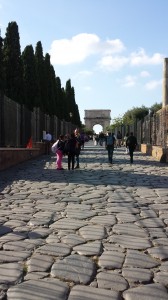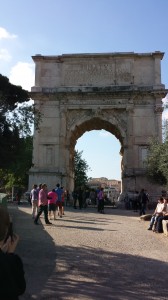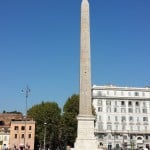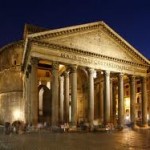Emperors liked to put their stamp on things by building things. And win they won some kind of victory, any kind of victory, they liked to put up arches on major roads so they could march through them in their victory parades. There are two prominent famous arches near the Forum and Colosseum (actually three in toto). We will consider the arch of Constantine and the arch of Titus. Now the arch of Constantine which is several centuries younger than the arch of Titus, is under heavy repair and surrounded by scaffolding as you can see below…
 This arch is the one immediately behind and nearest to the Colosseum. This arch is much more ornate than the arch of Titus.
This arch is the one immediately behind and nearest to the Colosseum. This arch is much more ornate than the arch of Titus.
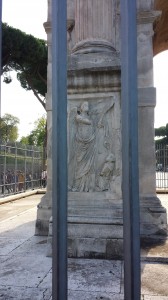 Notice the angel and the skeleton, presumably the angel that calls the dead out of the graves.
Notice the angel and the skeleton, presumably the angel that calls the dead out of the graves.
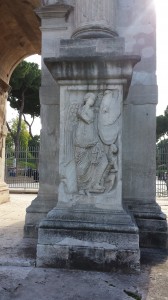 We have another scene with an angel at the other end of the arch.
We have another scene with an angel at the other end of the arch.
Looking then at the top of the arch the following is noticable…

Notice the extra column structure and the roundels with scenes from the life of Constantine in them.
Of a simpler sort, and in a much more prominent setting is the arch of Titus up on Palatine hill..
Notice the huge inscription at the top about the Senate honoring Titus for his conquest of the Jews (and the destruction of the Temple in Jerusalem in A.D. 70). Notice as well the lack of faux columns or roundels or other sort of ornamentation on this arch. It is in fact the inside of the arch here which is of most historical importance as it has pictures of the actual triumphal parade in Rome (called a ‘triumph’).
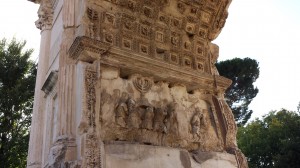
Here you see the famous image of the carrying of the menorah from the Temple through the streets of Rome, along with other booty, not to mention prisoners being carted off to execution. Ancient Roman triumphs were indeed much like modern parades, with floats and the whole nine yard. The difference of course is that these were war triumph parades, with the triumphal general having red dust put on his face depicting him as the general of both the war god Mars, and of Jupiter Optimus Maximus.

On the other side of the inside of the arch we have…

Here we see Titus himself in his chariot, leading the parade, so to speak. it is interesting that Paul on more than one occasion refers to the Roman Triumph and his being like one of the captives being dragged along at the end of the procession. For example in 1 Corinthians 4.9 we read—“For it seems to me that God has put us apostles on display at the end of the procession, like those condemned to die in the arena. We have been made a spectacle to the whole universe, to angels as well as to human beings.” And in 2 Corinthians 2.14-16 we have…
“But thanks be to God, who always leads us as captives in Christ’s triumphal procession and uses us to spread the aroma of the knowledge of him everywhere. 15 For we are to God the pleasing aroma of Christ among those who are being saved and those who are perishing. 16 To the one we are an aroma that brings death; to the other, an aroma that brings life.” You get the sense that Paul has seen such a triumph, and has smelled the bedraggled victims being dragged at the back of the parade to their deaths.


